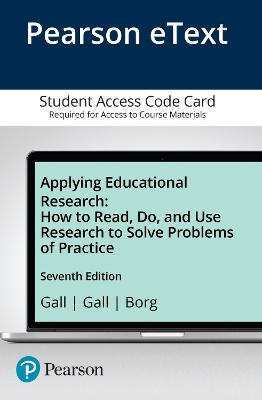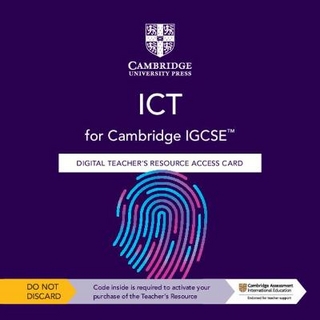
Applying Educational Research
Pearson (Hersteller)
978-0-13-339881-6 (ISBN)
- Titel z.Zt. nicht lieferbar
- Versandkostenfrei innerhalb Deutschlands
- Auch auf Rechnung
- Verfügbarkeit in der Filiale vor Ort prüfen
- Artikel merken
Pearson eText is an easy-to-use digital textbook that you can purchase on your own or instructors can assign for their course. The mobile app lets you keep on learning, no matter where your day takes you -- even offline. You can also add highlights, bookmarks, and notes in your Pearson eText to study how you like.
NOTE: This ISBN is for the Pearson eText access card. Pearson eText is a fully digital delivery of Pearson content. Before purchasing, check that you have the correct ISBN. To register for and use Pearson eText, you may also need a course invite link, which your instructor will provide. Follow the instructions provided on the access card to learn more.
Meredith “Mark” Gall, professor emeritus, has a bachelor’s degree and master’s degree in education from Harvard University and a Ph.D. in psychology from the University of California at Berkeley. He was an R & D specialist at the Far West Laboratory for Educational Research and Development and then a professor of education at the University of Oregon, where he served in various capacities, including head of teacher education and director of graduate studies in curriculum and instruction. His specializations include research methodology, teacher development, teaching strategies, and the psychology of studying. He has served on the editorial boards of several journals, including the Journal of Experimental Education, Journal of Educational Research, and Elementary School Journal. Among his other book publications are Educational Research: An Introduction and Clinical Supervision and Teacher Development. Joyce P. “Joy” Gall has a bachelor’s degree in journalism from the University of Illinois at Urbana- Champaign and a Ph.D. in psychology from the University of California at Berkeley. She has worked as a trainer-developer at the Far West Laboratory for Educational Research and Development, the American Institutes for Research, ROLM Corporation, and the University of Oregon. Her specializations include educational leadership, the psychology of studying, and training and development in education and industry. Her other books include Educational Research: An Introduction, Making the Grade, Help Your Son or Daughter Study for Success, and Tools for Learning: A Guide to Teaching Study Skills .
Table of Contents
PART 1: INTRODUCTION
Chapter 1: Using Research Evidence to Improve Educational Practice
Evidence-Based Professional Practice
Evidence-Based Practice in Education
The Purpose of Educational Research
Characteristics of Research as an Approach to Inquiry
Quantitative and Qualitative Research
Collaborating with Researchers
A Personal Note: The Research “Spark”
An Example of How Research Can Help in Solving Problems of Practice
Self-Check Test
Article: How Students’ Sleepy Brains Fail Them
Chapter 2: Doing Your Own Research: From Proposal to Final Report
Identifying a Research Problem
Outlining a Research Proposal
Other Steps in the Research Process
Self-Check Test
Sample Outline of a Quantitative Research Proposal
Sample Outline of a Qualitative Research Proposal
PART 2: APPLYING THE RESEARCH LITERATURE TO PROBLEMS OF PRACTICE
Chapter 3: Conducting and Writing Your Own Literature Review
Informal Literature Reviews
Formal Literature Reviews
Professional Literature Reviews
A Systematic Procedure for Doing Formal Literature Reviews
Parts and Presentation of a Literature Review
Self-Check Test
Article: The Case For and Against Homework
Article: The Process Writing Approach: A Meta-Analysis
Chapter 4: Using Search Engines and Available Literature Reviews
The Purpose of Search Engines
Selecting a Useful Search Engine
Using Search Engines
Obtaining a Publication after a Literature Search
Locating Published Literature Reviews
Criteria for Evaluating Published Literature Reviews
An Example of How Literature Reviews Can Help in Solving Problems of Practice
Self-Check Test
PART 3: USING QUANTITATIVE METHODOLOGY TO STUDY PROBLEMS OF PRACTICE
Chapter 5: Analyzing and Evaluating Reports of Quantitative Research Studies
Organization of a Quantitative Research Report
Abstract and Introduction
Method Section: Sampling Procedures
Method Section: Measures
Method Section: Research Design and Procedures
Results Section
Discussion Section
An Example of How Quantitative Research Can Help in Solving Problems of Practice
Self-Check Test
Article: Developing a Measure of Behavior Change in a Program to Help Low-Income Parents Prevent Unhealthful Weight Gain in Children
Chapter 6: Using Descriptive Statistics to Study Problems of Practice
Constructs, Variables, and Measurement Scales
Statistical Analysis of Data
Descriptive Statistics
Multivariate Descriptive Statistics
Calculating Descriptive Statistics
An Example of How Descriptive Statistics Can Help in Solving Problems of Practice
Self-Check Test
Chapter 7: Tests of Statistical Significance
The Logic of Statistical Significance and Confidence Intervals
Inferential Statistics
Tests of Statistical Significance
Calculating Statistics
Using Statistics to Improve Professional Practice
An Example of How Tests of Statistical Significance Can Help in Solving Problems of Practice
Self-Check Test
Chapter 8: The Practical Significance of Statistical Results
The Practical Significance of Statistical Results
Comparisons with Personal and Organizational Standards
Comparisons with Ideal Standards
Comparisons with Curriculum Standards
Comparisons Based on Rankings
Comparisons Involving Tables of Norms
Comparisons Involving Standard Scores
Effect Sizes
Gain Scores
Practical Significance as an Interpretive Process
An Example of How Determining the Practical Significance of Statistical Results Can Help in Solving Problems of Practice
Self-Check Test
Article: Can Growth Ever Be beside the Point?
Chapter 9: Descriptive Research
The Relevance of Descriptive Research to Educational Practice
Examples of Descriptive Research
Features of a Descriptive Research Report
Evaluating a Descriptive Research Study
An Example of How Descriptive Research Can Help in Solving Problems of Practice
Self-Check Test
Article: Examining the Extent and Nature of Online Learning in American K-12 Education: The Research Initiatives of the Alfred P. Sloan Foundation
Chapter 10: Group Comparison Research
Classification of Quantitative Research Designs
The Relevance of Group Comparison Research to Educational Practice
Examples of Group Comparison Research
Features of a Group Comparison Research Report
Evaluating a Group Comparison Research Study
An Example of How Group Comparison Research Can Help in Solving Problems of Practice
Self-Check Test
Article: Jordanian Prospective and Experienced Chemistry Teachers’ Beliefs about Teaching and Learning and their Potential for Educational Reform
Chapter 11: Correlational Research
Comparison of Correlational and Group Comparison Research Designs
Examples of Correlational Research
Correlation between Two Variables
Correlation Involving More Than Two Variables
Features of a Correlational Research Report
Evaluating a Correlational Research Study
An Example of How Correlational Research Can Help in Solving Problems of Practice
Self-Check Test
Article: The Measurement and Predictive Ability of Metacognition in Middle School Learners
Chapter 12: Experimental Research
The Relevance of Experimental Research to Educational Practice
Characteristics of Experiments
Examples of Experimental Research
Features of a Report of a Pretest–Posttest Control-Group Experiment with Randomization
Other Group Experiment Designs
Threats to the Internal Validity of Experiments
Threats Directly Involving the Experimental Intervention
Threats to the External Validity of Experiments
Single-Case Experiments
Features of a Report of a Single-Case Experiment
Evaluating an Experimental Research Study
An Example of How Experimental Research Can Help in Solving Problems of Practice
Self-Check Test
Article: After-School Multifamily Groups: A Randomized Controlled Trial Involving Low-Income, Urban, Latino Children
Article: Increasing On-Task Behavior in the Classroom: Extension of Self-Monitoring Strategies
PART 4: USING QUALITATIVE METHODOLOGY TO STUDY PROBLEMS OF PRACTICE
Chapter 13: Case Studies in Qualitative Research
How Qualitative Case Study Research Can Help Educators Solve Problems of Practice
Key Characteristics of Case Studies
Examples of Case Studies
The Nature of Qualitative Research
Qualitative Research Traditions
Features of a Case Study Report
Checking the Applicability of Case Study Findings
Evaluating the Quality and Rigor of a Case Study
An Example of How Case Study Research Can Help in Solving Problems of Practice
Self-Check Test
Article: Teaching Secrets: Ask the Kids!
Article: Exemplary Social Studies Teachers’ Use of Computer-Supported Instruction in the Classroom
Chapter 14: Ethnography and Critical Research
The Use of Critical Ethnography to Study Problems of Practice in Education
The Characteristics of Ethnographic Research
Differences between Ethnographies and Basic Case Studies
Examples of Ethnographic Research
Critical Research as a Field of Inquiry and Practice
Foundations of Critical Research in Education
Features of a Critical Ethnographic Research Report
Evaluating Ethnographies and Critical Ethnographies
An Example of How Ethnography and Critical Research Can Help in Solving Problems of Practice
Self-Check Test
Article: A Visual Ethnography on Pedagogy, Aesthetics, and the Spatial Experience of Growing Up Urban
Chapter 15: Narrative Research
Narratives as a Focus for Research
Examples of Narrative Research in Education
Features of a Narrative Research Report
Evaluating a Narrative Research Study
An Example of How Narrative Research Can Help in Solving Problems of Practice
Self-Check Test
Article: Teacher Identity and Early Career Resilience: Exploring the Links
Chapter 16: Historical Research
The Nature of Historical Research
The Role of Historical Research in Education
Methods of Historical Research
Identifying Historical Sources
Validating Historical Evidence
Interpreting Historical Data
Features of a Historical Research Report
Evaluating Historical Research
An Example of How Historical Research Can Help in Solving Problems of Practice
Self-Check Test
Article: Go To the Principal’s Office: Toward a Social History of the School Principal in North America
PART 5: COMBINING QUANTITATIVE AND QUALITATIVE METHODOLOGIES TO STUDY PROBLEMS OF PRACTICE
Chapter 17: Mixed-Methods Research
The Need for Multiple Research Methods
Types of Mixed-Methods Research
Reading a Mixed-Methods Research Report
Evaluating Reports of Mixed-Methods Studies
An Example of How Mixed-Methods Research Can Help in Solving Problems of Practice
Self-Check Test
Article: A Portrait of Administrator, Teacher, and Parent Perceptions of Title I School Improvement Plans
PART 6: USING OTHER RESEARCH METHODOLOGIES TO STUDY PROBLEMS OF PRACTICE
Chapter 18: Action Research
The History of Action Research
Using Action Research to Address Problems of Practice
Examples of Action Research Studies
Design Features of Action Research
How Action Research Differs from Educators’ Other Approaches to Problem Solving
Purposes and Benefits of Action Research
Applying Action Science to Action Research
The Insider–Outsider Perspective in Collaborative Action Research
Evaluating the Credibility and Trustworthiness of Action Research Projects
An Example of How Action Research Can Help in Solving Problems of Practice
Self-Check Test
Article: Recognizing a “Different Drum” Through Close-Reading Strategies
Chapter 19: Evaluation Research
The Use of Evaluation Research in Educational Decision Making
Examples of Evaluation Research
Programs as a Focus of Evaluation Research
Evaluation Research as a Political Activity
Models of Evaluation Research
How to Read an Evaluation Research Report
Evaluating an Evaluation Research Study and Uses of Evaluation in Educational Practice
An Example of How Program Evaluations Can Help in Solving Problems of Practice
Self-Check Test
Article: What Did the Teachers Think? Teachers’ Responses to the Use of Value-Added Modeling as a Tool for Evaluating Teacher Effectivenes
Self-Check Test Answers Appendix 1 Guide for Outlining a Quantitative or Qualitative Research Proposal Appendix 2 Search Options in the ERIC Search Machine Appendix 3 Questions To Ask Yourself When Evaluating a Report of a Quantitative Study Appendix 4 Questions to Ask Yourself When Evaluating a Report of a Qualitative Study Appendix 5 Design-Specific Questions to Ask Yourself When Evaluating a Research Report Glossary
| Erscheint lt. Verlag | 23.6.2014 |
|---|---|
| Sprache | englisch |
| Maße | 100 x 100 mm |
| Gewicht | 100 g |
| Themenwelt | Sozialwissenschaften ► Pädagogik |
| ISBN-10 | 0-13-339881-1 / 0133398811 |
| ISBN-13 | 978-0-13-339881-6 / 9780133398816 |
| Zustand | Neuware |
| Haben Sie eine Frage zum Produkt? |
aus dem Bereich
